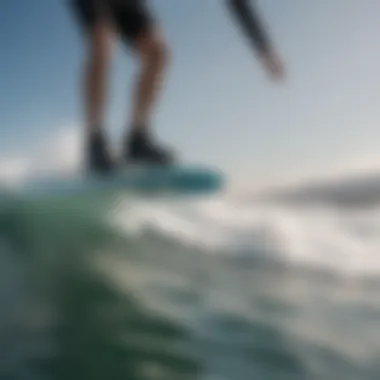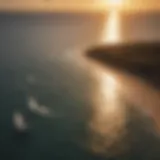Unveiling the Intricacies of Hydrofoil Board Mechanics: A Detailed Exploration


Equipment Reviews
A detailed examination of hydrofoil board equipment is crucial to understanding their operational dynamics. These boards usually comprise a mast, fuselage, front wing, rear wing, and stabilizer. Each component plays a vital role in maintaining stability while harnessing the power of the water to lift the board above its surface.
Kites
The kite, a pivotal element in hydrofoil boarding, serves as the primary source of propulsion. Variations in kite shapes, sizes, and materials can significantly influence performance. High aspect ratio kites, for example, offer greater upwind performance, while smaller kites are more maneuverable.
Boards
Hydrofoil boards come in different varieties, including twintips and directional boards. Twintips cater to riders who prefer freestyle tricks and jumps, while directional boards enhance stability and control during wave riding. Board construction materials, such as carbon fiber or fiberglass, impact weight and durability.
Accessories
Accessories like harnesses, lines, and safety gear are imperative for a safe and enjoyable hydrofoil boarding experience. Harnesses distribute the kite's pull, reducing strain on the rider. Quality lines ensure reliable control, while pumps assist in inflating kites efficiently. Proper safety gear, including helmets and impact vests, mitigate risks in case of falls or collisions.
Introduction
In the realm of watersports, the advent of hydrofoil boards has revolutionized the experience for enthusiasts. These cutting-edge watercraft operate on the principle of hydrodynamics, elevating riders above the water's surface for a truly exhilarating ride. Understanding the mechanisms behind hydrofoil boards is crucial for enthusiasts seeking to delve into this thrilling world.
Understanding the Basics of Hydrofoil Boards
Definition of Hydrofoil Boards
Hydrofoil boards are a class of watercraft equipped with a specialized underwater wing-like structure called a foil. This foil allows the board to lift above the water when in motion, significantly reducing drag and enhancing speed. The design of hydrofoil boards represents a paradigm shift in water sports technology, offering riders a unique and dynamic experience that defies conventional surfing norms.
Evolution of Hydrofoil Technology
The evolution of hydrofoil technology traces back to early experiments in aeronautics and naval architecture. Over time, engineers refined the design and materials used in hydrofoil construction, leading to the advanced boards available today. The evolution of hydrofoil technology showcases a relentless pursuit of innovation to enhance performance and push the boundaries of water sport possibilities.
Key Components of a Hydrofoil Board
Fuselage
The fuselage of a hydrofoil board serves as the central structural component that houses the foil system. Its aerodynamic shape plays a critical role in maintaining stability and directing water flow for optimal performance. A well-designed fuselage enhances rider control and overall maneuverability on the board, making it a key element in the functionality of hydrofoil boards.


Front Wing
The front wing of a hydrofoil board is instrumental in generating lift and controlling overall ride stability. Its unique profile and surface area are optimized to ensure efficient lift generation while maintaining responsive handling. The design of the front wing directly impacts the board's performance in terms of speed and responsiveness, making it a crucial component for riders seeking a dynamic experience on the water.
Rear Wing
The rear wing of a hydrofoil board acts as a stabilizing element, counterbalancing the forces exerted by the front wing during motion. Its design is strategically engineered to enhance the board's stability and control at varying speeds and riding conditions. A well-crafted rear wing contributes significantly to rider confidence and comfort, providing a smoother and more controlled glide above the water.
Masts
Masts on a hydrofoil board are the vertical supports that connect the wings to the fuselage, facilitating the transfer of forces between components. The length and construction of masts directly influence the board's performance characteristics, such as responsiveness, lift efficiency, and maneuverability. Choosing the right mast configuration is paramount for riders looking to optimize their experience based on riding style and water conditions.
Benefits of Hydrofoil Boards
Enhanced Speed
One of the standout advantages of hydrofoil boards is their ability to reach impressive speeds due to reduced hydrodynamic drag. By lifting the board above the water, foils minimize contact resistance, allowing riders to glide swiftly across the water's surface with minimal friction. This enhanced speed capability opens up new possibilities for riders seeking adrenaline-charged thrills on the water.
Reduced Drag
The innovative design of hydrofoil boards significantly reduces drag compared to traditional watercraft. As the foil lifts the board above the surface, drag forces are mitigated, enabling smoother and more efficient movement through the water. Riders experience less resistance, translating to improved performance and control, making hydrofoil boards a game-changer in the world of water sports.
Smooth Ride
Hydrofoil boards offer riders a remarkably smooth and stable ride, thanks to their advanced design features. The reduction in turbulent water movements beneath the foil creates a buttery-smooth riding experience, even in choppy conditions. The enhanced stability and control provided by hydrofoil boards ensure that riders can navigate varying water conditions with confidence, guaranteeing a ride like no other on the waves.
The Science Behind Hydrofoil Board Performance
In this section, we delve into the critical aspects that drive the performance of hydrofoil boards, shedding light on the complexities that underpin their functionality. Understanding the scientific principles behind how hydrofoil boards operate is crucial for enthusiasts and athletes alike. By dissecting the intricate mechanisms at play, we can appreciate the engineering prowess required to achieve optimal performance in this exhilarating watersport domain.
Hydrodynamics Principles at Play
Lift Generation
Examining lift generation is pivotal in comprehending the forces that enable hydrofoil boards to elevate above the water. By harnessing the dynamics of lift, riders can achieve remarkable stability and height during their ventures. The key characteristic of lift generation lies in its ability to create an upward force, countering the gravitational pull on the board. This fundamental principle is instrumental in facilitating smooth gliding and enhancing overall ride experience for kitesurfers.


Drag Reduction
The realm of drag reduction is a critical facet in optimizing hydrofoil board performance. By efficiently minimizing drag, riders can propel through water with minimal resistance, enabling higher speeds and smoother maneuvers. The key characteristic of drag reduction is its capacity to streamline the airflow around the foil, diminishing the drag force acting against forward motion. This streamlined approach aids in enhancing speed and efficiency, essential for navigating various water conditions.
Stability Factors
Exploring stability factors unveils the foundational elements that dictate how hydrofoil boards maintain balance and control on water surfaces. Stability features are essential in ensuring riders can maneuver with precision and confidence. The key characteristic of stability factors is their role in mitigating sudden movements and maintaining equilibrium throughout the ride. By prioritizing stability, riders can push their limits while enjoying a safe and gratifying hydrofoil experience.
Effects of Foil Design on Performance
Aspect Ratio
The aspect ratio of hydrofoil wings plays a pivotal role in determining the lift-to-drag ratio and overall stability of the board during operation. An optimal aspect ratio contributes to efficient lift generation and reduced drag, enhancing the board's performance in varying conditions. The unique feature of aspect ratio lies in its ability to influence the board's responsiveness and control, offering riders a well-rounded experience on the water.
Thickness Profile
The thickness profile of the foil directly impacts its hydrodynamic efficiency and maneuverability. A well-designed thickness profile ensures smooth water interaction and optimal lift generation, crucial for achieving high speeds and precise handling. The key characteristic of thickness profile lies in its ability to streamline water flow and minimize energy losses, translating into improved performance and responsiveness for riders.
Wing Shape
The shape of the hydrofoil wings significantly influences the board's maneuverability, stability, and speed capabilities. By exploring different wing shapes, riders can tailor their board's performance to suit their riding style and preferences. The unique feature of wing shape is its versatility in adapting to various water conditions, offering riders enhanced agility and control during their hydrofoil adventures.
Mechanisms of Hydrofoil Board Operation
When delving into the intricacies of hydrofoil boards, one cannot overlook the crucial topic of mechanisms governing their operation. Understanding the mechanisms behind hydrofoil board operation is essential for enthusiasts, kitesurfers, and extreme athletes alike. This section aims to dissect the nuances of how hydrofoil boards function, from the fundamental principles to the advanced maneuvering techniques.
Riding Dynamics of a Hydrofoil Board
Balancing Act
Exploring the realm of hydrofoil board riding dynamics offers a fascinating insight into the delicate balance required to master this extreme sport. The balancing act on a hydrofoil board demands precision, skill, and a keen sense of spatial awareness. Riders must constantly adjust their position to counteract the forces acting upon them, ensuring a smooth and controlled glide above the water's surface. The art of balancing on a hydrofoil board is a skill coveted by enthusiasts worldwide, showcasing the intricate interplay between rider and equipment.
Control Inputs
The realm of control inputs on a hydrofoil board is where the magic truly unfolds. Riders harness the power of control inputs to navigate the waters with unparalleled agility and finesse. From subtle movements to decisive adjustments, control inputs dictate the trajectory and speed of the hydrofoil board, allowing riders to glide with effortless grace. Understanding the nuances of control inputs is paramount for every hydrofoil board enthusiast, as it holds the key to unlocking the full potential of this exhilarating water sport.


Maneuverability
Maneuverability is the cornerstone of hydrofoil board operation, offering riders the freedom to execute intricate turns, jumps, and tricks with precision. The unparalleled maneuverability of hydrofoil boards sets them apart from traditional watercraft, inviting riders to explore new realms of possibility on the water. By harnessing the power of maneuverability, riders can push the boundaries of their skill and creativity, crafting a fluid and dynamic performance that mesmerizes onlookers and fellow enthusiasts.
Transitioning from Water to Foil-Borne State
Initiating Lift-Off
The moment of initiating lift-off on a hydrofoil board marks a transition like no other – a seamless shift from water to air. Initiating lift-off requires a harmonious blend of technique and timing, as riders must harness the forces beneath them to ascend above the water's surface. This pivotal moment encapsulates the thrill and excitement of hydrofoil boarding, propelling riders into a realm where gravity and freedom intersect. Mastering the art of initiating lift-off is a milestone every enthusiast strives to achieve, as it signifies the beginning of an exhilarating aerial escapade.
Maintaining Optimal Glide
Once airborne, maintaining optimal glide becomes the focal point for riders seeking to harness the full potential of their hydrofoil board. Sustaining a smooth and stable glide requires finesse and control, as riders navigate the invisible currents that dictate their trajectory. By honing the art of maintaining optimal glide, riders can extend their flight time, explore new heights, and experience the pure, unadulterated joy of defying gravity. This aspect of hydrofoil board operation epitomizes the essence of freedom and exhilaration that drives enthusiasts to push the boundaries of their capabilities.
Challenges and Considerations in Hydrofoil Board Usage
In this section of our article, we delve into the essential aspects surrounding the utilization of hydrofoil boards, presenting a comprehensive guide to understanding the challenges and considerations inherent in their usage. An in-depth exploration of the difficulties and key factors affecting the performance of hydrofoil boards is imperative for enthusiasts and novices alike to navigate the waters effectively.
Learning Curve for Beginners
Initial Stabilization Challenges:
Within the realm of hydrofoil boarding, conquering the initial stabilization challenges forms a crucial milestone for beginners. These challenges contribute significantly to the learning curve of novice riders as they strive to find equilibrium on the board. The intricate balance required to master this aspect underscores its importance in laying a solid foundation for progressing in the sport. The unique feature of initial stabilization challenges lies in their ability to build core stability and enhance proprioception, essential elements for effective hydrofoil control.
Refining Control Techniques:
Embarking on the journey of refining control techniques marks a pivotal stage in the development of a hydrofoil board rider. This aspect plays a vital role in honing the rider's skills and achieving greater precision in maneuvering the board. The distinctive characteristic of refining control techniques lies in their capacity to enhance responsiveness and fluidity in movements, elevating the overall riding experience. While presenting challenges, mastering control techniques offers immense satisfaction and paves the way for increased confidence on the water.
Environmental Factors Impacting Hydrofoil Performance
Wind Conditions:
Navigating the complexities of wind conditions stands as a fundamental consideration in optimizing hydrofoil performance. Understanding the impact of varying wind speeds and directions is vital for harnessing the full potential of hydrofoil boards. The key characteristic of wind conditions lies in their dynamic and ever-changing nature, requiring riders to adapt swiftly to different scenarios. Embracing the challenges posed by diverse wind conditions empowers riders to refine their skills and excel in diverse wind patterns.
Water Depth:
Exploring the implications of water depth unveils another layer of environmental factors influencing hydrofoil performance. The significance of maintaining an awareness of water depth cannot be understated, as it directly impacts the maneuverability and stability of the board. The unique feature of water depth lies in its role in determining the optimal conditions for hydrofoil activities, guiding riders to select suitable locations for their aquatic adventures. Adapting to varying water depths challenges riders to exercise precision and adaptability in their hydrofoil endeavors.
Obstacle Awareness:
Elevating one's awareness of obstacles in the water is paramount for ensuring a safe and enjoyable hydrofoil experience. Recognizing and maneuvering around obstacles represent essential skills that riders must cultivate to safeguard themselves and their equipment. The key characteristic of obstacle awareness is its role in promoting rider safety and minimizing the risk of collisions or accidents. Developing a keen sense of obstacle awareness empowers riders to navigate challenging environments with confidence and composure.







